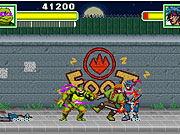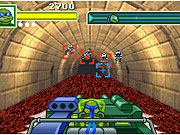You couldn't go anywhere in the late 1980s and early 1990s without encountering the Teenage Mutant Ninja Turtles. Their likenesses were everywhere--in comic books, in toy stores, on movie screens, on the Saturday-morning cartoon lineup, on lunchboxes, and yes, even in video games. Not bad for a black-and-white comic book started by two guys in their garage. For whatever reason, the franchise ran out of steam sometime around 1995, leaving behind it a legacy of nearly a dozen games for the arcade, NES, Super NES, Sega Genesis, and Game Boy platforms. One of these games, Teenage Mutant Ninja Turtles IV: Turtles in Time for the Super NES, is widely regarded as the cream of the crop of TMNT video games. With Turtles in Time, Konami captured the attitude and style of the Turtles and their enemies perfectly and did so in a beat-'em-up of the same caliber as the venerable Final Fight or Streets of Rage.

The Teenage Mutant Ninja Turtles burst back onto the scene in late 2002, and the fad picked up right where it left off. Comic books are flying off store shelves, the Fox cartoon show is killing in the ratings, toy stores can hardly keep the action figures in stock, and Konami has unleashed a new set of games for the current generation of Turtles fans. When Konami first announced that the Game Boy Advance would be getting a TMNT game, many nostalgia buffs hoped that the company would simply convert Teenage Mutant Ninja Turtles IV: Turtles in Time for play on Nintendo's popular handheld. Instead, Teenage Mutant Ninja Turtles for the Game Boy Advance is a brand-new game that combines simple beat-'em-up gameplay with the kind of run-and-jump action that has been done so often, and oftentimes much better, in numerous other side-scrolling games.
In many ways, the game just feels underdeveloped. Leonardo, Donatello, Michelangelo, and Raphael all have a wide variety of normal and special attacks, but there's no compelling reason to select a charge-based move when constantly tapping the B button is quicker and more effective. Enemies hardly fight back as it is. Gang members will walk into view and just stand there while you hack away at their stamina. The levels are pretty straightforward as well. Once in a while, you'll find a ladder that you need to climb or a set of platforms that you need to jump across, but these sorts of tasks are few and far between. It's rare that you'll look at something in the environment and think to yourself, "That's cool."
Nevertheless, TMNT on the GBA does have its cool moments. Each turtle has his own set of four levels designed to emphasize the unique abilities of that particular character. Leonardo can duck and crawl through sewer tunnels, Raphael can use his sais to climb up walls like Spider-Man, Donatello can use his staff to launch himself across wide gaps, and Michelangelo can use walls to propel himself higher into the air. TMNT fans will probably appreciate Leo's and Raph's stages the most, since they feature appearances by mouser attack robots and the hockey-stick-wielding vigilante, Casey Jones. Each turtle also has a different minigame stage as one of his levels. These minigames are fairly basic--sewer surfing, tank driving, hang gliding, and motorcycle racing--but they do give you a break from all of the fighting.
More often than not, these cool moments just remind you that the game isn't as fleshed out as it ought to be. TCRI billboards and burrowing mousers are nice details, but the environment isn't snazzy enough. Leo's stages don't have enough alternate routes, Raph's stages provide too few opportunities to use his climbing abilities, and Michelangelo's and Don's stages don't have nearly enough jumping sections. Most players will run through the game from beginning to end in under an hour. If you replay levels in order to collect the 20 crystals you need to unlock the last motorcycle bonus game, it may take two hours. The lack of a two-player link feature is also painfully obvious, since the best TMNT games in the past have allowed multiple players to team up with one another.

Owing to the fact that the environments don't offer much to look at, the graphics come across as blah. The character designs are great--each turtle has the proper skin tone, weapons, and accessories--and the animation is smooth, but it's hard to be wowed when you're standing in front of a brick wall fighting enemies that don't fight back. The audio fares a little better. Much of the music sounds identical to what plays during the cartoon on Fox, and the variety of sound effects is a good mix of punches, thuds, and, slaps. The game needs a few more speech samples--such as the familiar "dudes" and "cowabungas" that the turtles exclaim during the cartoon show--but there are a couple of "whoas" and "ouches" here and there.
While devoted fans may be able to look past the game's shortcomings and enjoy Teenage Mutant Ninja Turtles on the Game Boy Advance, most players would be better off skipping this one.